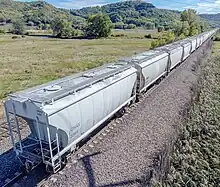
A covered hopper is a self-clearing, enclosed, weatherproof railroad freight car. It has a fixed roof, sides, and ends with openings for loading through the top and unloading through the bottom. Covered hopper cars are designed for carrying dry bulk loads, such as grain, sand, clay and Portland cement.[1]
History

Historically, open hopper cars were used to carry coarse mined products like coal, ore, and gravel, while boxcars were used for granular materials requiring protection from the elements.
Weatherproof covers were added to hopper cars, creating the covered hopper. Although removable canvas covers are sometimes used to protect moisture sensitive commodities in open hopper cars, a metal top with waterproof loading hatches provides superior protection.[2] These loading hatches along the top of the covered hopper may be a single long opening along the centerline or a pattern of multiple round or square openings positioned to allow uniform weight distribution when loading the car.
Some covered hoppers have two to four separate bays, with chutes at the bottom to direct unloading contents. Early production emphasized two-bay cars very similar to open coal hoppers and suitable for materials of similar density, like Portland cement or rock-salt. Some cars were available in the 1910s, and became more common by the 1940s. These early cars were volume-limited for less dense commodities like grain or sugar, so later designs include longer covered hopper cars with higher sides and three or more bottom bays.[3] Increasing axle load limits have allowed some of the heavier loads formerly assigned to two-bay hoppers to be assigned to larger, more efficient three-bay hoppers.
Some covered hopper cars retain the conventional centersill as a strength member transmitting compression and tension forces from one car to the next. Beginning in the 1960s, designs distributing these forces along the sides of the car eliminated the centersill beam to simplify bulk material handling with wider hopper openings reducing the tendency for bridging to restrict gravity flow when unloading the car.[4]
Large unit trains of various grain crops are a common sight in North America, reaching up to 125 cars long. These predominantly haul grain from the large farming areas of the Great Plains to various markets, but a number of unit trains originate from other major farming areas, such as Illinois and Indiana as well as the Canadian provinces of Alberta, Saskatchewan and Manitoba. These trains may originate from a single grain elevator, or may be marshaled in a yard from various locals (short trains which serve nearby industries). The destinations tend to be large flour mills or ports (for export), or they may be split up and delivered to multiple locations. The empty cars may return as a whole train, or may be sent back in smaller quantities on manifest trains (trains which carry just about any type of freight). These trains are used primarily for hauling products such as corn, wheat and barley.
Gallery
 a two-bay through-sill CSX covered hopper |
 Covered hopper of the Dakota, Minnesota and Eastern Railroad |
 |
References
- ↑ Walthers, W. K. (1937). Handbook for Model Railroaders. Wauwatosa, Wisconsin: The Modelmaker Corporation. p. 114.
- ↑ Henry, Robert Self (1942). This Fascinating Railroad Business (First ed.). New York: The Bobbs-Merrill Company. pp. 248 & 249.
- ↑ Sweetland, David R.; Horsley, Stephen (1994). Northern New England Color Guide to Freight and Passenger Equipment. Edison, New Jersey: Morning Sun Books. pp. 35, 36 & 51. LCCN 94075695. OCLC 32243319.
- ↑ "Centerflow Cars". American Railcar Industries, Inc. Retrieved 24 June 2020.